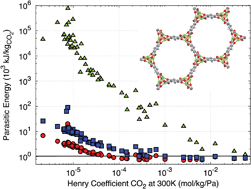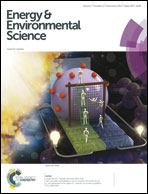Evaluating different classes of porous materials for carbon capture†
Abstract
Carbon Capture and Sequestration (CCS) is one of the promising ways to significantly reduce the CO2 emission from power plants. In particular, amongst several separation strategies, adsorption by nano-porous materials is regarded as a potential means to efficiently capture CO2 at the place of its origin in a post-combustion process. The search for promising materials in such a process not only requires the screening of a multitude of materials but also the development of an adequate evaluation metric. Several evaluation criteria have been introduced in the literature concentrating on a single adsorption or material property at a time. Parasitic energy is a new approach for material evaluation to address the energy load imposed on a power plant while applying CCS. In this work, we evaluate over 60 different materials with respect to their parasitic energy, including experimentally realized and hypothetical materials such as metal–organic frameworks (MOFs), zeolitic imidazolate frameworks (ZIFs), porous polymer networks (PPNs), and zeolites. The results are compared to other proposed evaluation criteria and performance differences are studied regarding the regeneration modes, (i.e. Pressure-Swing (PSA) and Temperature-Swing Adsorption (TSA)) as well as the flue gas composition.


 Please wait while we load your content...
Please wait while we load your content...